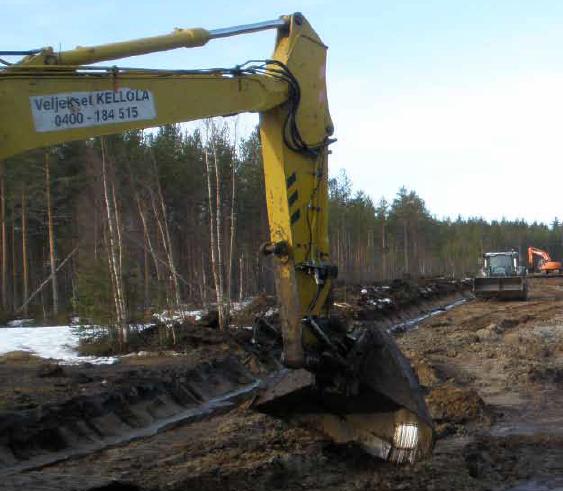
Nordic Mines has already sold some of the gold from its mine in Finland: Laiva will make Nordic one of Europe’s leading gold producers—and the timing couldn’t be better.
It seems a long time since Western economies abandoned the gold standard. In reality it’s only really since World War Two that the value of currency stopped being underpinned by gold reserves and we seem to have got along well enough without it. But at around $1,500 an ounce on the world’s metal markets, gold is at an all-time high at present. Maybe this has as much to do with supply and demand in the jewellery trade as with the global banking collapse, but there’s no denying that when the stock market wobbles, gold starts to look like a very reassuring investment.
So this is a good time to be a gold producer. And the market fundamentals conspire to favour any company that can promise to supply the growing demand. Gold prices have risen steadily over the last 60 years, points out Michael Nilsson, the CEO of OMX Nordic Exchange-listed Nordic Mines, but gold production will actually decline until 2015 or beyond. “Some of the traditional resources are beginning to be mined out and there will have to be a lot of success in exploration to fill the shortfall.” Since prices shot up, there has been a rush to find gold resources around the world, but it takes years to turn a discovery into a producing mine.
Nordic Mines does not have that problem. Founded at Uppsala in 2005 to explore and secure mineral properties, the company has focused on gold production and will be producing gold at a plant next to its mine at Laiva, near the city of Raahe in Finland, well before the end of 2011. But even better than that, it has already sold something over a third of its projected output for the next four years.
In March it signed a contract that secures 36 per cent of the planned gold production at the mine in Laiva at an average price, after transaction costs, of €1,049 per ounce until the first quarter of 2015. It’s a hedging move, explains Nilsson: “The price of gold may well go even higher, which is why we only wanted to commit a proportion of our total production; but we are really happy to have secured the operating and financing costs at the Laiva mine over that period.” At that price there is not much risk anyway: the bankable feasibility study on the mine, published in March 2010, indicated that any price over €535 per ounce would put Laiva into profit.
Nevertheless, the price of gold is driven by expectation, says Nilsson. “Fluctuations can be driven by external events in the world. That’s why we wanted to have a hedge that would protect us in case the price goes down in the short term. This way we won’t be severely affected.” This caveat out of the way, he soon reverts to optimism. The recession caused a drop in demand for jewellery in 2008; but in 2010 the trend reversed. “Jewellery is back as a major player in this market: as economies recover the market expects the demand for jewellery to increase. Over the coming five years we expect a very strong gold price to be maintained.”
With that incentive the company is working flat out to complete the mine and the processing plant. Waste rock removal has already started and the mining fleet is being built up ready to start ore mining at the end of June or very early in July. This first ore will be stockpiled until the processing plant comes into operation in the second half of August.
Processing will be carried out in a concentrator located about one kilometre from the mine site. Ore will be hauled to the crusher, ground and trucked to the ore stockpile before being fed to the primary mill. Following screening of the milled material, the fine material will be sent to the secondary mill while coarse ore will be sent back to the primary mill. Under a €30 million contract, Metso Mining is installing a full range of equipment and services including a mill, pumps, flotation equipment, crushers and screens, steel structures, piping and a plant electrical, instrumentation and automation package, says Nilsson. “The plant has the capacity to process 250 tons of ore an hour, which amounts to two million tons annual throughput. There will be a ramp-up period but the plant will be in full production well before the end of this year.”
Any problems associated with mining in Scandinavia do seem to be high-class ones. Nordic Mining does not have to worry about access to power, water, road and rail transport or, in the land of Nokia, communications. “We have a world class deposit in a region where mining has been practised for at least 500 years, so an experienced workforce is readily available.” About 75 posts will be created this year, he says, and these attracted around 350 applications, many from Finns currently working in more remote areas.
Environmental regulations are definitely more rigorous than in other parts of the world but Nordic Mining grasped the environmental nettle from its earliest days, determined to keep its impact on the landscape and the community as low as possible. At Laiva, for example, there will be none of the wet tailings that are traditionally contained by a dam with the attendant risk of leakage and pollution. “The fine waste is going to be turned into an inert paste that can be stored and banked up on site. The advantage of using this paste technology is that the water from the tailings is recovered immediately and re-used over and over again in the plant. All that remains will be low hills, and on these we are going to plant forest,” promises Nilsson.
Laiva is what is known as an open resource—the 60,000 metre core drilling programme that established the reserve went down 160 metres but test drills indicate that gold bearing ore is present down to twice that depth. Nordic Mines will continue to drill after Laiva starts producing, and there is every chance the resource will prove much larger than so far established. The company has a number of other early stage projects up its sleeve including gold prospects at Oltava and Tormua in Finland and Fjälltuna in Sweden, and a promising lead/zinc resource at Alanäs, also in Sweden. But for the time being Laiva is set to make Nordic Mines a very hot property, all on its own.













